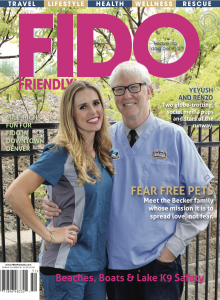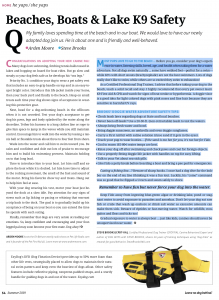Q: My family loves spending time at the beach and in our boat. We would love to have our newly adopted dog join us. He is about one and is friendly and well behaved.
MOST PUPS LOVE TO GO TO THE BEACH … Before you go, consider your dog’s experience in water, listening skills, breed, age, and health when taking them for a water adventure. Not all dogs swim naturally … some have webbed feet — perfect for a swim — while K9’s with short snouts (brachycephalic) are not the best swimmers. Lots of dogs really don’t like to swim, while others are so excited they swim to exhaustion!
As a Certified Professional Dog Trainer, I advise that before taking your dog to the beach, teach a solid recall and stay. I highly recommend that every pet owner learn K9 First Aid & CPR and watch for signs of heat stroke or hypothermia. A doggie visor is a good idea for light colored dogs with pink noses and fine hair because they are sensitive to harmful UV rays.
BROOKS’ DOGGIE WATER ADVENTURE SAFETY TIPS:
Check leash laws regarding dogs at State and local beaches.
Never been off-leash? Use a 20-30-ft. (non-retractable) leash to test the waters.
Always bring fresh water and bowl.
Bring doggie sunscreen, an umbrella and even doggie sunglasses.
Carry a First Aid kit with saline solution (rinse sand if it gets in the eyes).
Teach your pup to wear booties… If the sand is too hot for you, it’s too hot for Fido.
Cool to warm (65-80) water temps are best.
Rinse your dog off after swimming and check paws and coat for foreign objects.
Use a properly fitting doggie life jacket with handles on top for easy lifting.
Talk to your Vet about sea-sick pills.
Give Fido a potty break before boarding a boat and bring a pee pad for emergencies.
Casting a fishing line…? Beware of sharp hooks. I once had a dog dive for the bob- ber on the end of my line (thinking it was a fun toy). Luckily, his “come” command was so good that he flipped a U-turn and swam safely to shore.
Remember to have fun but never force your dog into the water.
Keep Fido away from ingesting blue-green algae or drinking lake, pond or stag- nant water to avoid exposure to parasites and amoebas. Don’t let your dog eat raw fish or crabs that wash up onshore or drink salt water as excessive amounts can make them sick. Beware of riptides or fast-moving water. Watch for wildlife, mos- quitos and fleas and ticks too!
Gradual exposure to water is always best … just like kids, canines should never be unsupervised near water.









